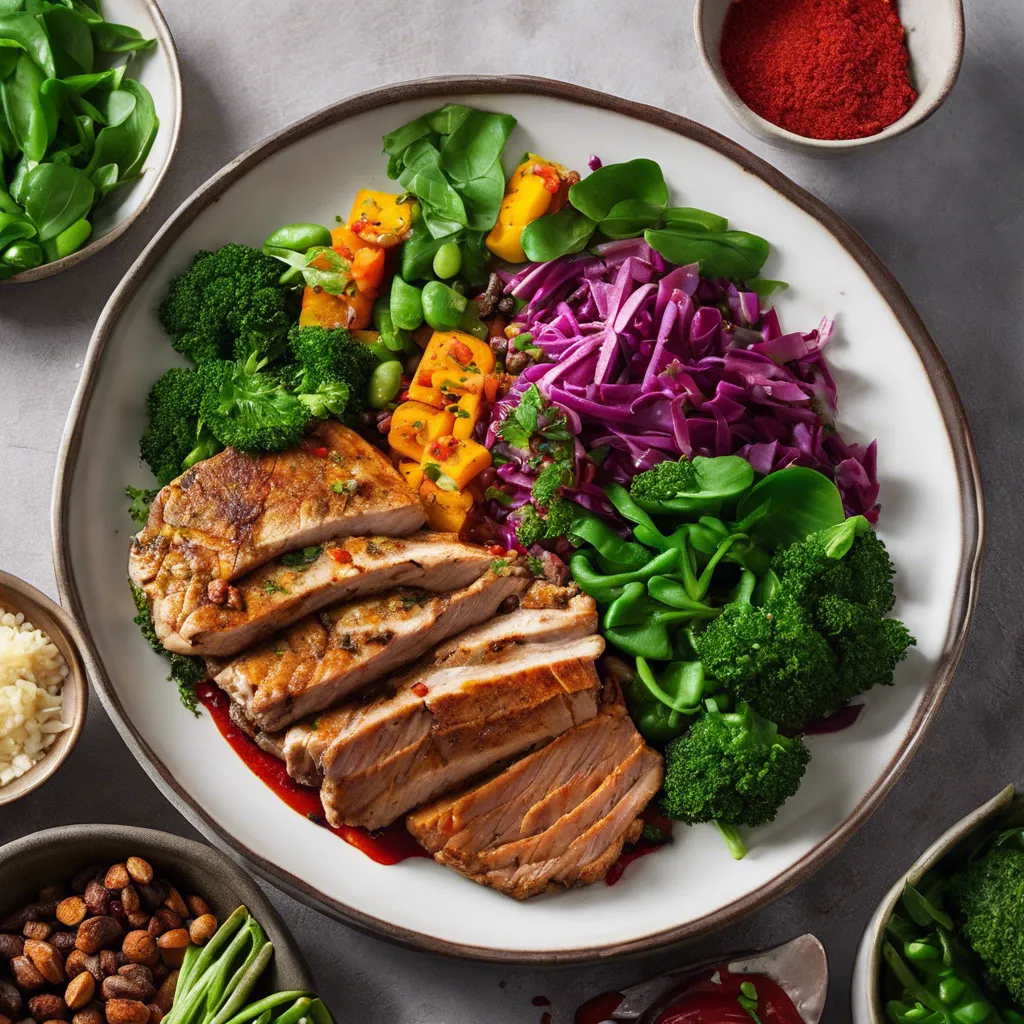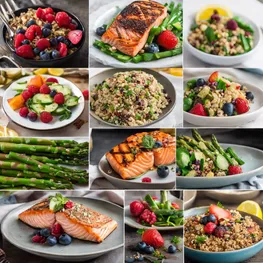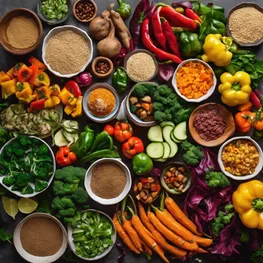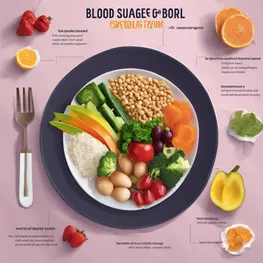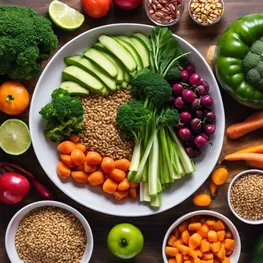Table of contents
- The Ins and Outs of Blood Sugar Levels: A Beginner's Guide
- The Impact of Diet on Blood Sugar Control
- The Importance of Key Nutrients in Controlling Blood Sugar
- Incorporating Culinary Creativity into Blood Sugar-Friendly Dishes
- Flavorful Recipes to Help Stabilize Blood Sugar Levels
- The Best Lifestyle Changes for Managing Your Blood Sugar Levels
In the realm of culinary creativity, discovering delicious dishes that also maintain stable blood sugar levels is a worthy pursuit. This article explores the art of crafting blood sugar-friendly meals that are both satisfying and nourishing. With innovative ingredient substitutions and mindful cooking techniques, embark on a journey to create flavorsome meals that prioritize your health without compromising taste. Get ready to indulge in a world of culinary delight while keeping your blood sugar in check.
The Ins and Outs of Blood Sugar Levels: A Beginner's Guide
Blood sugar levels refer to the concentration of glucose in the bloodstream. They are regulated by the hormone insulin, which is produced by the pancreas. When blood sugar levels rise, insulin helps cells absorb glucose, reducing the level. Conversely, when blood sugar levels drop, the pancreas releases glucagon, which prompts the liver to release stored glucose into the bloodstream to raise the levels.
The Impact of Diet on Blood Sugar Control
The impact of different macronutrients on blood sugar levels can vary. Carbohydrates have the greatest impact, especially simple sugars, as they are quickly digested and raise blood sugar levels rapidly. Protein has a minimal impact on blood sugar, as it is slowly digested. Fat has the least impact on blood sugar, as it does not raise it directly. However, a high-fat diet can affect blood sugar control indirectly by contributing to weight gain and insulin resistance. Therefore, understanding the impact of macronutrients is crucial for managing blood sugar levels effectively.
The Importance of Key Nutrients in Controlling Blood Sugar
Proper blood sugar management is crucial for overall health and well-being. It requires a combination of healthy lifestyle choices and the consumption of key nutrients that support blood sugar control. By understanding and incorporating these specific nutrients into your diet, you can effectively manage and regulate your blood sugar levels. Here are some important nutrients to highlight in this context:
-
1. Fiber
Fiber-rich foods, such as whole grains, fruits, and vegetables, help slow down the absorption of sugars into the bloodstream, preventing sharp spikes in blood sugar levels.
-
2. Chromium
Chromium is a mineral that plays a vital role in insulin function, which is responsible for regulating blood sugar levels. Including sources of chromium, such as broccoli, nuts, and lean meats, can help support blood sugar management.
-
3. Magnesium
Magnesium is essential for glucose metabolism and insulin action. Foods rich in magnesium, such as leafy greens, legumes, and whole grains, can contribute to better blood sugar control.
-
4. Vitamin D
Vitamin D deficiency has been linked to insulin resistance and increased risk of type 2 diabetes. Adequate levels of vitamin D, which can be obtained from sunlight exposure and fortified foods, are important for blood sugar management.
-
5. Omega-3 Fatty Acids
Omega-3 fatty acids, found in fatty fish, flaxseeds, and chia seeds, have been shown to improve insulin sensitivity and reduce inflammation, potentially benefiting blood sugar control.
Incorporating Culinary Creativity into Blood Sugar-Friendly Dishes
Using creative techniques and ingredients in blood sugar-friendly meals can provide numerous benefits. These methods can enhance the flavor and overall taste of the dishes while also improving their nutritional profile, making them more enjoyable and healthier for individuals watching their blood sugar levels.
Flavorful Recipes to Help Stabilize Blood Sugar Levels
Here are some delicious recipes that are both blood sugar-friendly and packed with flavor. These recipes include ingredients that help stabilize blood sugar levels while satisfying your taste buds.
The Best Lifestyle Changes for Managing Your Blood Sugar Levels
Managing blood sugar levels is crucial for individuals with diabetes or prediabetes. While diet and exercise play important roles, there are other lifestyle factors that can impact blood sugar levels as well. Exploring these factors can help individuals better manage their condition and improve their overall health.
-
Stress
Chronic stress can lead to elevated blood sugar levels. It triggers the release of stress hormones, which in turn raise glucose levels. Managing stress through relaxation techniques, exercise, and mindfulness can help regulate blood sugar levels.
-
Quality of sleep
Sleep deprivation can affect blood sugar control. Lack of adequate sleep can lead to insulin resistance and higher blood sugar levels. Maintaining a consistent sleep schedule and practicing good sleep hygiene can contribute to better blood sugar management.
-
Alcohol consumption
Alcohol can cause blood sugar levels to rise or fall unpredictably. It is essential for individuals with diabetes to moderate alcohol intake and monitor their blood sugar levels accordingly.
-
Smoking
Smoking is detrimental to overall health, and it can also affect blood sugar levels. Smoking impairs insulin's ability to process glucose, leading to higher blood sugar levels. Quitting smoking can significantly improve blood sugar control.
-
Physical activity
Regular exercise helps regulate blood sugar levels by increasing insulin sensitivity. Engaging in activities such as walking, cycling, or strength training can have a positive impact on blood sugar management.
In conclusion, culinary creativity plays a significant role in crafting blood sugar-friendly dishes. By understanding the impact of certain ingredients and cooking techniques on blood sugar levels, individuals can create flavorful and nutritious meals that won't cause sharp spikes or drops in glucose. The key lies in incorporating low glycemic index foods, balancing macronutrients, and using cooking methods that retain the nutritional value of the ingredients. With these principles in mind, it becomes possible to enjoy a diverse and satisfying diet while maintaining stable blood sugar levels, promoting overall health and wellbeing.
Frequently asked questions related to crafting blood sugar friendly dishes
What is culinary creativity?
Culinary creativity refers to the ability to create innovative and unique dishes using different cooking techniques, flavors, and ingredients. It involves thinking outside the box and combining unexpected elements to produce exciting and delicious meals.
Why is it important to craft blood sugar-friendly dishes?
Crafting blood sugar-friendly dishes is important for individuals with diabetes or those who are concerned about managing their blood sugar levels. These dishes are specifically designed to help control blood glucose spikes by incorporating low glycemic index ingredients, controlling portion sizes, and balancing carbohydrates with protein and fiber.
Can you provide some examples of blood sugar-friendly ingredients?
Certainly! Some blood sugar-friendly ingredients include quinoa, sweet potatoes, whole wheat pasta, lean meats like turkey or chicken breast, fish rich in omega-3 fatty acids such as salmon and mackerel, non-starchy vegetables like broccoli and spinach, and healthy fats like avocados and nuts. These ingredients are low in glycemic index, high in fiber, and contain essential nutrients.
Are there any resources or cookbooks available for blood sugar-friendly recipes?
Yes, there are many resources and cookbooks available that provide blood sugar-friendly recipes. Some popular ones include 'The Diabetic Cookbook' by Stella Metsovas, 'The Type 2 Diabetes Cookbook' by Michelle Anderson, and 'The Blood Sugar Solution Cookbook' by Mark Hyman. These books offer a variety of delicious and nutritious recipes specifically tailored for individuals looking to manage their blood sugar levels.
What are some tips for creating blood sugar-friendly dishes?
Some tips for creating blood sugar-friendly dishes include choosing whole grains instead of refined grains, using healthy fats like olive oil and avocados, incorporating lean proteins, such as chicken or fish, and adding plenty of non-starchy vegetables to your meals. It's also important to watch portion sizes and limit the use of added sugars and processed ingredients.
Are there specific cooking techniques that can make dishes blood sugar-friendly?
Yes, there are specific cooking techniques that can make dishes blood sugar-friendly. For example, steaming, roasting, and grilling are great options as they require little or no added fats. These techniques help preserve the natural flavors and nutrients of the ingredients without adding extra calories or sugars. Additionally, using herbs, spices, and citrus juices can enhance the taste of dishes without relying on excessive amounts of salt or sugar.
